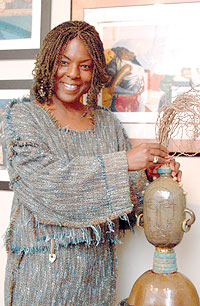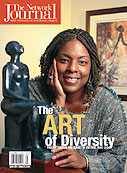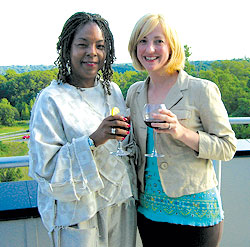
|
Is it possible to explore diversity and create dialogue among diverse groups through art? Can art help combat racism, discrimination and prejudice in the workplace? Can a company effectively use art to change the attitudes of its employees, fostering shared cultural appreciation and understanding? Valerie Cooper seems to think so. As founder of Picture That LLC, a Stamford, Conn., company that helps to promote cultural awareness and diversity through art, the 43-year-old former vice president of global diversity for Goldman Sachs’ technology division has taken a passion for art and turned it into a viable business. Starting out in 1987 as an art collector, Cooper gradually developed a personal connection to African-American art. As she learned more about her newfound hobby, she quickly realized the significance of African-American art as a reflection of the culture of African-Americans in the United States. “Learning about my culture was totally unexpected,” explains Cooper. “I learned about fine art, artists such as Joshua Johnson from the 1800s and the temperament of our people in America,” she recalls with enthusiasm. From Passion to Profit Designating herself an art dealer, Cooper began to sponsor other individuals interested in selling African-American art from their homes. By 1992 she had gained a solid reputation and following. Her knowledge of art increased, and so did her visibility. She began to enhance her credentials by lecturing and teaching about art in the continuing education program at the University of Connecticut and at classes sponsored by the city of Stamford. She booked art shows, which led her to establish relationships with African-American organizations such as the National Black MBA Association and 100 Black Men of America Inc., for whose special events she provided African-American art. Training Ground By the last three years of her tenure at Goldman Sachs, Cooper had already honed her diversity expertise and established solid contacts for her own business. In 2001, she resigned from her 15-year career with the nation’s premier investment firm to formally launch Picture That, borrowing the expression she and her sister use when a seemingly improbable event actually occurs. The branding of the name Picture That, however, had begun in her early days as an art dealer. Spreading the Message “From my diversity days at Goldman Sachs, as I developed strategic diversity plans globally, there were always workshops and seminars, but it was a hard sell to white males, to let them understand what was in it for them. In terms of cultural differences, through a piece of art, the diversity message is subtle but powerful. It speaks a thousand words,” states Cooper. Margaret Gibson concurs. As director of workplace diversity for Cendant Mobility, Gibson is responsible for helping Cendant achieve its diversity goals and for shaping future diversity initiatives. Having met Cooper at a minority supplier event in Connecticut at which Cooper presented Picture That’s art portfolio, Gibson decided that Cendant Mobility’s diversity outreach would be enhanced by using the services of Picture That. “It helps us to reach out to minority suppliers. The artwork used in our exhibits represents the population of our employees and those with whom we do business,” says Gibson.
For the past two years Picture That has curated exhibits at Cendant Mobility’s Danbury, Conn., headquarters “We first did two art exhibits; now we do six,” says Gibson. “We define diversity to go beyond race and gender. We define diversity as the different elements you bring to the workplace. We value diverse ideas and diverse backgrounds,” she adds. Handling Growth Although she relishes her newfound independence as an entrepreneur, Cooper has been forced to learn some valuable business lessons, such as how to manage cash flow. “I had to become sensitive to adhering to a budget and managing expenses. Before getting my own business this wasn’t a concern,” she concedes. “There is also another set of dynamics to learn when you are not hiring the vendor but you are the vendor. I’ve learnt that the customer is always right and to treat customers fairly.” Guidance from mentors in her early art dealer days has been priceless,
says Cooper. She counts the proprietors of June Kelley Gallery,
Peg Alston Gallery, DC Moore Gallery and the late Essie Green of
Essie Green Galleries among her mentors. “I would visit their
galleries and call on them when I needed art for exhibits, and they
would lend it to me. They also helped me to educate my audience
as to who the significant artists are and how to price for my services
based on the artist, time and mediums,” she says. |
|||||


